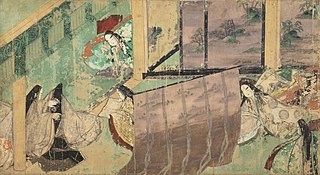


The Genji Monogatari Emaki (源氏物語絵巻), also called The Tale of Genji Scroll, is a famous illustrated handscroll of the Japanese literature classic The Tale of Genji, produced during the 12th century, perhaps c. 1120–1140. The surviving sections, now broken up and mounted for conservation reasons, represent only a small portion of the original work (if it was complete) and are now divided between two museums in Japan, Tokugawa Art Museum and the Gotoh Museum, where they are only briefly exhibited, again for conservation reasons. Both groups are National Treasures of Japan. It is the earliest surviving text of the work and the earliest surviving work in the Yamato-e tradition of narrative illustrated scrolls, which has continued to impact Japanese art, arguably up to the present day. The painted images in the scroll show a tradition and distinctive conventions that are already well developed, and may well have been several centuries in the making.[1]
- ^ Paine, 133–134